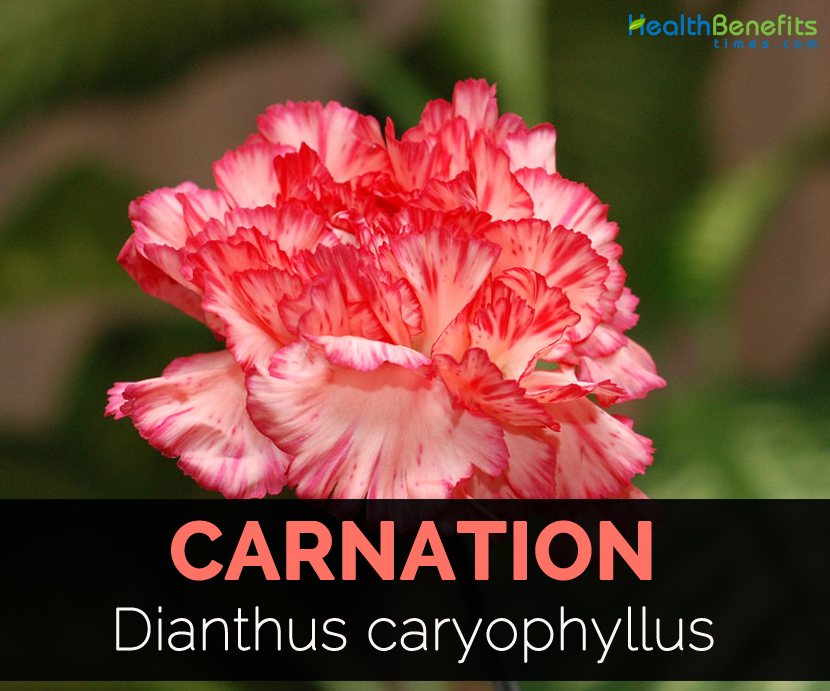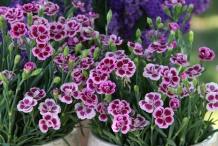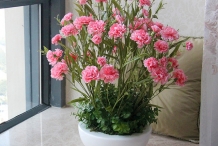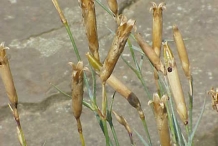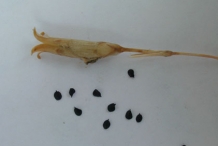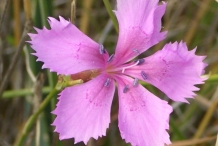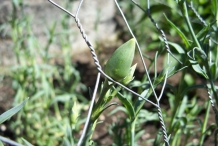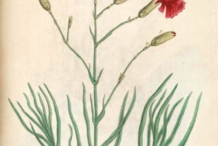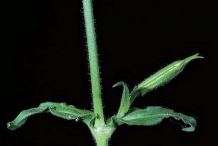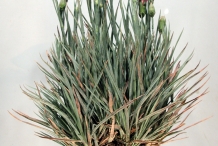Most of the plant is herbaceous annuals or perennials. Leaves are rarely whorled and opposite. Blades are petiolate, entire and stipulate. Flowers are hermaphrodite, terminal blooming singly or in branched or forked in cymes. Flowers are regular with five sepals and five white to pink to purple petals. Petals are fringed or deeply cleft at the end. Stems are woody at the base but have herbaceous branches. Leaves are slender, glaucous grayish green to blue-green measuring 15 centimeters long.
Plant
Carnation is a herbaceous perennial plant growing 50 to 80 cm tall having erect and branching herbaceous stem which is woody at the base. Leaves are glaucous, opposite, lanceolate to linear lanceolate and is about 10 to 15 cm long. Flowers are solitary, bisexual, sweetly scented about 3.5 to 6 cm diameter. Single flower have 5 petals and double flowers have 10 to 40 petals. Petals are obovate or broadly cuneate, serrated or clawed, red, orange, purple, white, pink, yellow and green and spotted or variegated.
Traditional uses
- In European herbal medicine, Carnation is used for treating nervous and coronary disorders.
- It is used as a tonic for fevers.
- The tea provides relief from nervousness and stress.
- It is used for treating muscles spasms, increase sweat production, improve heart health and calm nervous system.
- It is also helpful for treating problems such as excessive gas, hair loss and sore muscles.
- Its oil is used to lower wrinkles and soothe numerous skin problems.
- For sore and aching muscles, use 100 ml of vinegar by adding petals of 10 carnations. Let it remain for a day and add it to bath water.
- Carnation oils are used for treating skin rash and also act as a conditioner for skin.
- It is used to lower fever and pain.
- It is used to provide relief from chest congestion.
Precautions
It might cause allergic symptoms in sensitive people.
How to Eat
- Flower petals are used as a garnish in salads, candied, added to fruit salads, punch bowl, soups and flavoring fruit.
- It is also used as a substitute for rose petals in making syrup.
- It is used to add flavor in wine, beer and other alcoholic beverages.
- It could be added to desserts.
Other Facts
- It is propagated by seeds and plant cuttings.
- Carnation is the national flower of Spain, Monaco, Ohio and Slovenia.
- Carnation is a perennial plant which survives for more than 2 years.
References:
https://www.itis.gov/servlet/SingleRpt/SingleRpt?search_topic=TSN&search_value=506587#null
http://www.newworldencyclopedia.org/entry/Carnation
http://www.softschools.com/facts/plants/carnation_facts/637/
https://www.prestigeflowers.co.uk/flower_press/interesting-ways-using-carnations/
http://carnationflowerimages.blogspot.com/2012/07/medicinal-uses-of-carnations.html
Comments
| Carnation Quick Facts | |
|---|---|
| Name: | Carnation |
| Scientific Name: | Dianthus caryophyllus |
| Origin | Native to Mediterranean region. |
| Health benefits | Treat nervous and coronary disorders, Relieve nervousness and stress, Treat muscle spasms, Soothe skin problems, Lower fever and pain |
| Name | Carnation |
|---|---|
| Scientific Name | Dianthus caryophyllus |
| Native | Native to Mediterranean region. |
| Common/English Name | Border Carnation, Common Carnation, Carnation, Clove Pink, Dianthus, Gillyflower, Divine Flower, Pinks, Wild Carnation, Carnation, Clove Pink |
| Name in Other Languages | Bohemian: Hvozdik, Vrsta Karanfila; Brazil: Cravo, Craveiro; Burmese: Zaw-Hmwa-Gyi; Catalan: Clavell, Clavellina, Claveller, Clavillinera, Clavells, Clevellina; Chinese: Kang Nai Xin, Dà huā shízhú (大花石竹), Kāngnǎixīn (康乃馨), Shī tóu shízhú (狮头石竹), Xiāng shízhú (香石竹), Shèxiāng shízhú (麝香石竹); Corsican: Caròfanu, Uchjellu, Gaiofi nu; Czech: Hvozdík Zahradní, Hvozdík Karafi át; Danish: Havenellike; Dutch: Tuinanjelier; Estonian: Šaboonelk; Esperanto: Dianto Ĝardena; Finnish: Tarhaneilikka; French: Oeillet Girofle, Oeillet Des Fleuristes, Oeillet giroflée; German: Garten-Nelke, Nelke, Land-Nelke, Edel-Nelke; Hungarian: Kerti Szegfű; Icelandic: Goðadrottning; Indonesia: Bunga Anyelir; Italian: Dianto, Garofano, Garofano Coltivato; Japanese: Oranda-Nadeshiko; Malaysia: Bunga Teluki; Norwegian: Hagenellik; Polish: Goździk Ogrodowy; Portuguese: Craveiro, Cravelinha, Cravina, Cravina-Dos-Jardins Cravo; Russian: Gvozdika Sadovaja, Gvozdika Gollandskaja, gvozdika gollandskaya (гвоздика голландская), gvozdika sadovaya (гвоздика садовая); Slovašcina: Vrtni Nageljček; Slovencina: Klinček Záhradný; Spanish: Clavel, Clavel Común, Claveles, Clavel Canario, Clavelina; Swedish: Trädgårdsnejlika; Turkish: Karanfil Familyasından Çiçek, Bahçe Karanfili; Vietnamese: Cẩm Nhung, Cẩm Chướng Thơm, Hương Nhung Hoa; Welsh: Ceinan Gwyllt, Penigan Pêr, Clows, Penigan Rhuddgoch |
| Plant Growth Habit | Herbaceous perennial plant |
| Growing Climate | Cool |
| Soil | Well-drained, rich sandy-loam or loamy sand |
| Leaves | Greyish green to blue-green, up to 15 cm long |
| Flower | Pinkish to purple, 3 to 5 cm diameter |


